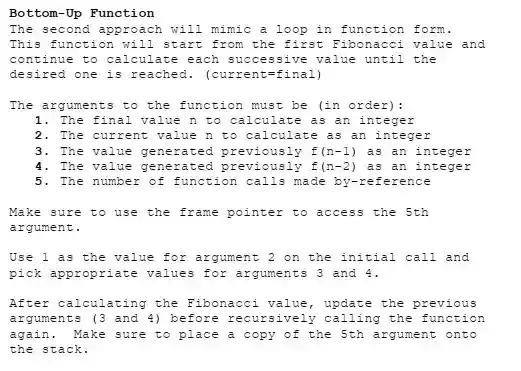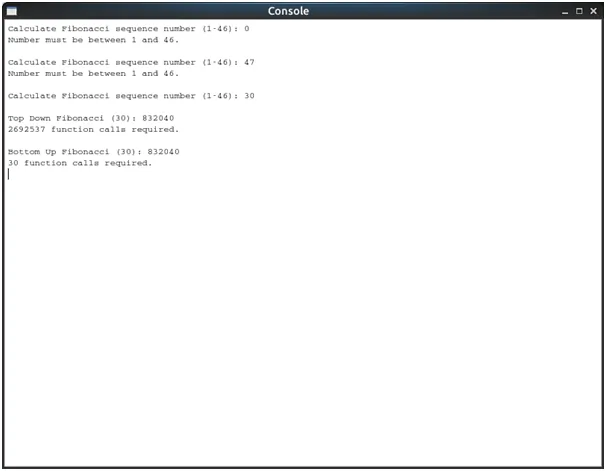Instructions
Objective
Write an assembly language assignment routine in MIPS running on QtSpim that calculates fibonacci value using recursion.
Requirements and Specifications
.webp)

Screenshots of output

Source Code
.data
#; System Service Codes
SYSTEM_EXIT = 10
SYSTEM_PRINT_INTEGER = 1
SYSTEM_PRINT_STRING = 4
SYSTEM_READ_INTEGER = 5
#; Input Parameters
MAXIMUM_FIBONACCI = 46
MINIMUM_FIBONACCI = 1
#; Strings
n: .word 0
answer: .word 0
newLine: .asciiz "\n"
errorRange: .asciiz "Number must be between 1 and 46.\n"
inputString: .asciiz "Calculate Fibonacci sequence number (1-46): "
resultString: .asciiz " function calls required."
resultTopDown: .asciiz "Top Down Fibonacci ("
resultBottomUp: .asciiz "Bottom Up Fibonacci ("
closeParenthese: .asciiz "): "
.text
.globl main
.ent main
main:
# Output the prompt message
li $v0, SYSTEM_PRINT_STRING
la $a0, inputString
syscall
# Reads input
li $v0, SYSTEM_READ_INTEGER
syscall
move $t1, $v0
checkRangeInput:
bltu $t1, MINIMUM_FIBONACCI, invalidRange
bgtu $t1, MAXIMUM_FIBONACCI, invalidRange
j validRange
invalidRange:
# Outputs error message for range input of Fibonacci number
li $v0, SYSTEM_PRINT_STRING
la $a0, errorRange
syscall
# Prints new line for formatting.
li $v0, SYSTEM_PRINT_STRING
la $a0, newLine
syscall
# Reprompt
li $v0, SYSTEM_PRINT_STRING
la $a0, inputString
syscall
# Reads input again.
li $v0, SYSTEM_READ_INTEGER
syscall
addi $t1, $v0, 0
j checkRangeInput
validRange:
move $s0, $t1
# Prints new line for formatting.
li $v0, SYSTEM_PRINT_STRING
la $a0, newLine # load address of string
syscall
# Call the function
move $a0, $s0 # copy number to argument
la $a1, n # load address of number of calls
li $t0, 1 # save 1 as initial number of calls
sw $t0, 0($a1)
jal recursiveFibonacci # calculate fib(number, &ncalls)
addu $s1, $zero, $v0 # save fib(n) result in s1
# print result message
li $v0, SYSTEM_PRINT_STRING
la $a0, resultTopDown
syscall
li $v0, SYSTEM_PRINT_INTEGER
move $a0, $s0 # load number n
syscall
li $v0, SYSTEM_PRINT_STRING
la $a0, closeParenthese # load address of string
syscall
li $v0, SYSTEM_PRINT_INTEGER
move $a0, $s1 # load top-down fib(n) result
syscall
# Prints new line for formatting.
li $v0, SYSTEM_PRINT_STRING
la $a0, newLine # load address of string
syscall
# print number of calls
li $v0, SYSTEM_PRINT_INTEGER
la $t0, n # load address of number of calls
lw $a0, 0($t0)
syscall
li $v0, SYSTEM_PRINT_STRING # syscall number to print a string
la $a0, resultString # load address of string
syscall
# Prints new line for formatting.
li $v0, SYSTEM_PRINT_STRING
la $a0, newLine # load address of string
syscall
# Prints new line for formatting.
li $v0, SYSTEM_PRINT_STRING
la $a0, newLine # load address of string
syscall
move $a0, $s0 # copy number to argument
li $a1, 1 # current value to calculate is 1
li $a2, 1 # set f(n-1) as 1
li $a3, 0 # set f(n-2) as zero
la $t0, n # load address of number of calls
li $t1, 1 # save 1 as initial number of calls
sw $t1, 0($t0)
addi $sp, $sp, -4 # push last argument
sw $t0, 0($sp)
jal loopedFibonacci # calculate fib(number, curn, f(n-1), f(n-2), &ncalls)
addi $sp, $sp, 4 # restore stack pointer
addu $s1, $zero, $v0 # save fib(n) result in s1
# print result message
li $v0, SYSTEM_PRINT_STRING
la $a0, resultBottomUp
syscall
li $v0, SYSTEM_PRINT_INTEGER
move $a0, $s0 # load number n
syscall
li $v0, SYSTEM_PRINT_STRING
la $a0, closeParenthese # load address of string
syscall
li $v0, SYSTEM_PRINT_INTEGER
move $a0, $s1 # load top-down fib(n) result
syscall
# Prints new line for formatting.
li $v0, SYSTEM_PRINT_STRING
la $a0, newLine # load address of string
syscall
# print number of calls
li $v0, SYSTEM_PRINT_INTEGER
la $t0, n # load address of number of calls
lw $a0, 0($t0)
syscall
li $v0, SYSTEM_PRINT_STRING # syscall number to print a string
la $a0, resultString # load address of string
syscall
# Prints new line for formatting.
li $v0, SYSTEM_PRINT_STRING
la $a0, newLine # load address of string
syscall
endProgram:
li $v0, SYSTEM_EXIT
syscall
.end main
#; This function will calculate the Fibonacci value by calling itself.
#; Two arguments will be used:
#; 1. The Value n to calculate as an integer.
#; 2. The number of function calls made by reference.
.globl recursiveFibonacci
.ent recursiveFibonacci
recursiveFibonacci:
addi $sp, $sp, -16 # allocate space for registers in stack
sw $ra, 0($sp) # save return address in stack
sw $s0, 4($sp) # save s0 in stack
sw $s1, 8($sp) # save s1 in stack
sw $s2,12($sp) # save s2 in stack
li $v0, 0
beq $a0, $v0, rfReturn # if n == 0, return 0
li $v0, 1
beq $a0, $v0, rfReturn # if n == 1, return 1
move $s0, $a0 # save n in s0
move $s1, $a1 # save address of ncalls in s1
addi $a0, $a0, -1 # calculate n-1
lw $t0, 0($a1)
addi $t0, $t0, 1 # pass number of calls +1
sw $t0, 0($a1)
jal recursiveFibonacci # fib(n-1)
move $s2, $v0 # save fib(n-1) in s2
addi $a0, $s0, -2 # calculate n-2
lw $t0, 0($s1)
addi $t0, $t0, 1 # pass number of calls + 1
sw $t0, 0($s1)
move $a1, $s1
jal recursiveFibonacci # fib(n-2)
add $v0, $v0, $s2 # return fib(n-1) + fib(n-2)
rfReturn:
lw $ra, 0($sp) # load return address
lw $s0, 4($sp) # load s0 from stack
lw $s1, 8($sp) # load s1 from stack
lw $s2,12($sp) # load s2 from stack
addi $sp, $sp, 16 # remove allocated space from stack
jr $ra
.end recursiveFibonacci
#; This function will mimic loop structure for a recursive function to find
#; the Fibonacci value.
#; Five arguments will be used:
#; 1. The final value n to calculate as an integer.
#; 2. The current value n to calculate as an integer.
#; 3. The value generated previously f(n-1) as an integer.
#; 4. The value generated previously f(n-2) as an integer.
#; 5. The number of function calls made by reference.
.globl loopedFibonacci
.ent loopedFibonacci
loopedFibonacci:
addi $sp, $sp, -8 # allocate space for registers
sw $ra, 0($sp) # save return address in stack
sw $fp, 4($sp) # save frame pointer in stack
move $fp, $sp # save frame pointer
li $v0, 0
beq $a1, $v0, skip # if curn == 0, skip
li $v0, 1
beq $a1, $v0, skip # if curn == 1, skip
add $v0, $a2, $a3 # f(n) = f(n-1)+f(n-2)
beq $a0, $a1, loopEnd # if n = curn, return value
move $a3, $a2 # use f(n-1) as f(n-2)
move $a2, $v0 # use current f as f(n-1)
skip:
addi $a1, $a1, 1 # increment current n being calculated
lw $t0, 8($fp) # load argument from stack
lw $t1, 0($t0)
addi $t1, $t1, 1 # pass number of calls +1
sw $t1, 0($t0)
addi $sp, $sp, -4 # push last argument (ncalls reference)
sw $t0, 0($sp)
jal loopedFibonacci # fib(n,curn+1,f(n-1),f(n-2), &ncalls))
addi $sp, $sp, 4 # restore stack pointer
loopEnd:
lw $ra, 0($sp) # load return address from stack
lw $fp, 4($sp) # load frame pointer from stack
addi $sp, $sp, 8 # remove allocated space from stack
jr $ra
.end loopedFibonacci
Related Samples
At ProgrammingHomeworkHelp.com, we offer comprehensive assignment support to students, including an extensive collection of samples for Assembly Language. Our expertly crafted samples cover a wide range of Assembly Language topics, providing students with invaluable resources to excel in their studies. Whether you need help understanding complex concepts or assistance with specific assignments, our samples are designed to guide you through the intricacies of Assembly Language programming. Explore our repository and enhance your learning experience with ProgrammingHomeworkHelp.com.
Assembly Language
Assembly Language
Assembly Language
Assembly Language
Assembly Language
Assembly Language
Assembly Language
Assembly Language
Assembly Language
Assembly Language
Assembly Language
Assembly Language
Assembly Language
Assembly Language
Assembly Language
Assembly Language
Assembly Language
Assembly Language
Assembly Language
Assembly Language
